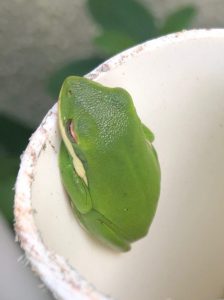
Some folks are a little squeamish about amphibians, but for me, it’s always delightful to see a treefrog clinging to one of my windows after a rain. My calico cat is even more delighted, often jumping 6 feet straight up in the air in a futile attempt to reach the critter on the other side of the glass! Treefrogs are often drawn to the outdoor lights of homes, which attract numerous insects the frogs can feed upon.
One of the most common species statewide (including some of the Keys) is the green treefrog (Hyla cinerea). As its common name indicates, it is a deep emerald green, with a whitish band outlined by brown or black running down the side of its body, from mouth to legs. The frog’s skin is smooth, and can vary in appearance to have spots or a brighter shade of spring green. Many people will find the male’s high-pitched call familiar on a summer night. You can listen to the call, described as a “quoonk” or “reeenk” sound, at this University of Georgia site.

The green treefrog bears many similarities to the squirrel treefrog, which comes in a variety of patterns and colors, including bright green. The green and squirrel treefrogs, along with 5 other arboreal species in Florida, are members of the Hyla genus, which is Greek for “belonging to the woods.” All of these species can be immediately identified as treefrogs by their large, sticky toepads that enable remarkable climbing skill.
Green treefrogs breed from March to October and lay eggs in almost any kind of standing water, including ditches, lakes, swamps, marshes, and ponds with fish. They feed on small insects and invertebrates like beetles, caterpillars, and stinkbugs. As adults, they typically live in trees within 100 yards of their breeding site.

If you are interested in providing frog habitat in your own yard, it is very simple. At our office, we’ve cut pieces of PVC into 2-3 foot sections, then stuck them upright in the ground. The hollow insides of the pipes are a perfect perch and hiding spot for treefrogs. Being low to the ground, this is a particularly great activity with children. They can observe the frogs easily and from a distance where the frogs don’t feel threatened.
For more on the diverse population of frogs in Florida, I highly recommend this full-color field guide written by to UF colleagues, including our statewide frog and lizard guru, Dr. Steve Johnson.
 0
0
